In an era where precision and speed are paramount, the emergence of Machine Learning in radiology has ushered in a new era of possibilities.
Did you know that ML algorithms can analyze medical images with an astounding accuracy of up to 98%?
Let’s explore the remarkable impact of Machine Learning in Radiology, delve into its key applications, and navigate the challenges and considerations that come with it.
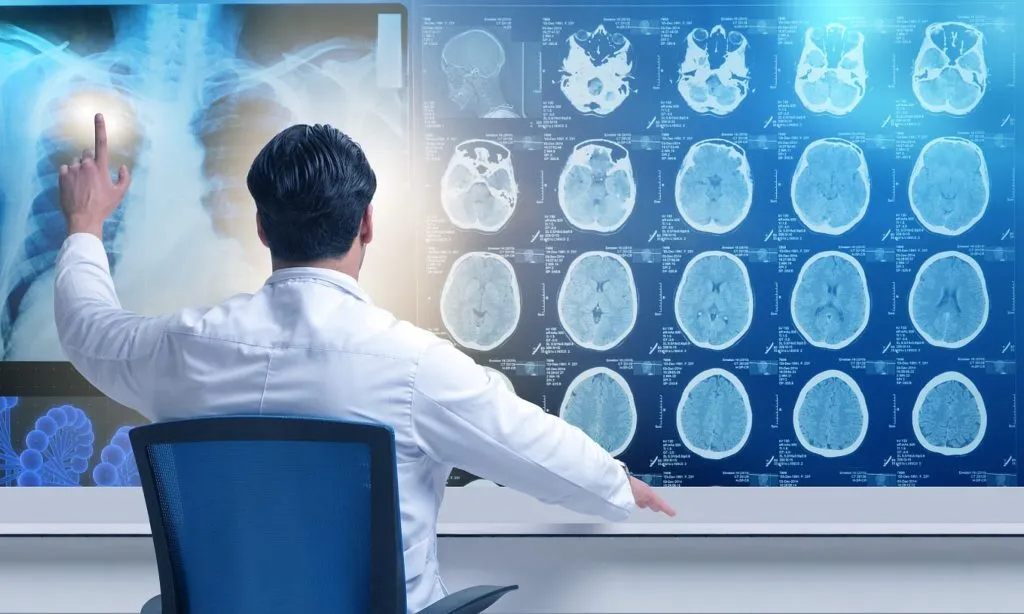
Emergence of Machine Learning in Radiology
In recent years, the world of radiology has seen a remarkable transformation with the advent of Machine Learning (ML). But what exactly is ML, and how is it changing the game in medical imaging?
Machine Learning is a technology that lets computers learn from data and predict the future without explicit programming.
Radiology Machine Learning means teaching computers to interpret and analyze medical images like X-rays, MRIs, and CT scans.
It’s like giving them a set of digital eyes that can spot subtle patterns, anomalies, and even potential diseases.
This emergence of ML and AI in radiologic diagnosis has been nothing short of a game-changer.
It’s not just about automating tasks or speeding up processes; it’s about enhancing accuracy and improving patient care.
Imagine having a second pair of eyes, consistently examining medical images for abnormalities, day or night. That’s the power of ML in radiology.
But how did we get here, and where are we headed with this technology?
Let’s delve deeper into the key applications, challenges, and exciting future ML trends in radiology to find out.
Key Applications of ML in Radiology
Machine Learning (ML) is making waves in radiology, bringing about transformative applications that benefit both healthcare providers and patients. Here are some key areas where Machine Learning in healthcare is making a significant impact:
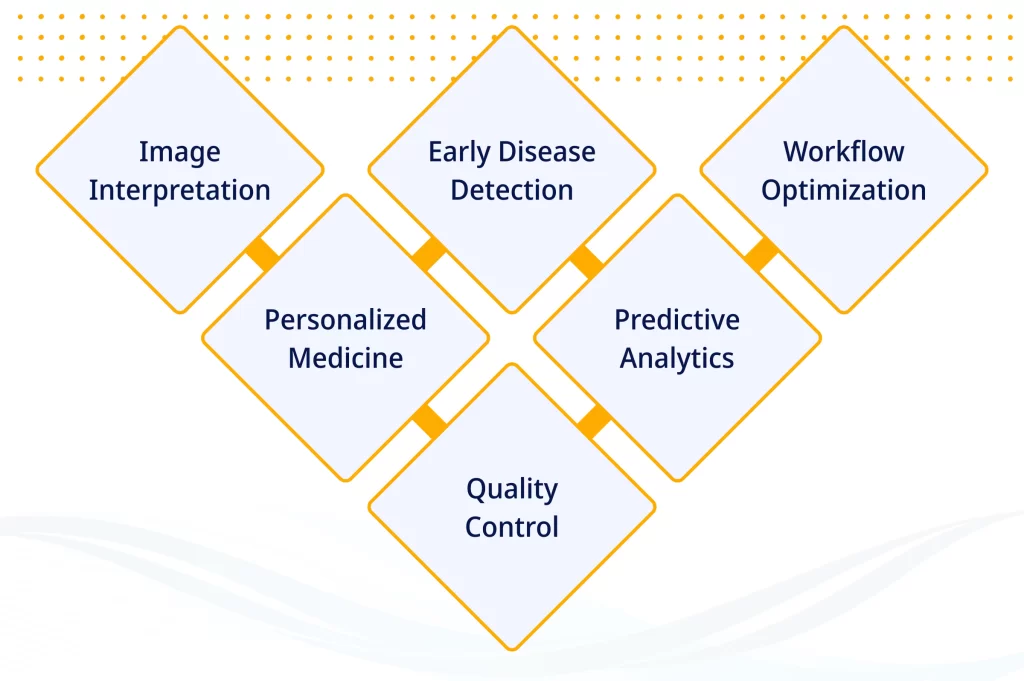
Image Interpretation: ML algorithms are trained on vast datasets of medical images.
They can recognize intricate patterns and anomalies in X-rays, MRIs, and CT scans that might be imperceptible to the human eye.
This capability aids radiologists in providing faster and more accurate diagnoses.
Early Disease Detection: ML’s ability to detect subtle changes in medical images is crucial for early disease detection.
For example, in mammography, ML algorithms can identify tiny microcalcifications or early-stage tumors that might go unnoticed in traditional readings.
Detecting diseases at their inception greatly improves treatment outcomes.
Workflow Optimization: Radiology departments often face high workloads.
Machine Learning solutions help manage this by automating routine tasks like report generation and data entry.
It can also prioritize urgent cases, ensuring that radiologists focus on critical diagnoses while reducing their workload.

Personalized Medicine: ML analyzes a patient’s medical history, genetics, and imaging results to create highly individualized treatment plans.
This approach tailors treatments to a patient’s unique needs, optimizing effectiveness and minimizing side effects.
Predictive Analytics: A Machine Learning development company can help forecast patient outcomes and the progression of diseases.
Considering historical data and patient profiles, it assists healthcare providers to informed decisions about treatment plans and adjusting interventions as needed.
Quality Control: ML continuously monitors the performance of imaging equipment.
It checks for factors like image quality, contrast, and sharpness, and alerts technicians to any deviations from the norm.
This ensures that scans are of the highest quality and reduces the need for patients to undergo additional scans due to poor image quality.
The application of machine learning in radiology collectively enhances the accuracy, efficiency, and patient-centric approach in radiology.
As ML technology evolves, it promises to usher in further advancements, ultimately leading to better healthcare outcomes and improved patient experiences.
Challenges and Considerations of ML in Radiology
While Machine Learning in radiology is revolutionizing, acknowledging the challenges and considerations that come with this transformative technology is essential. Here are some key points to ponder:
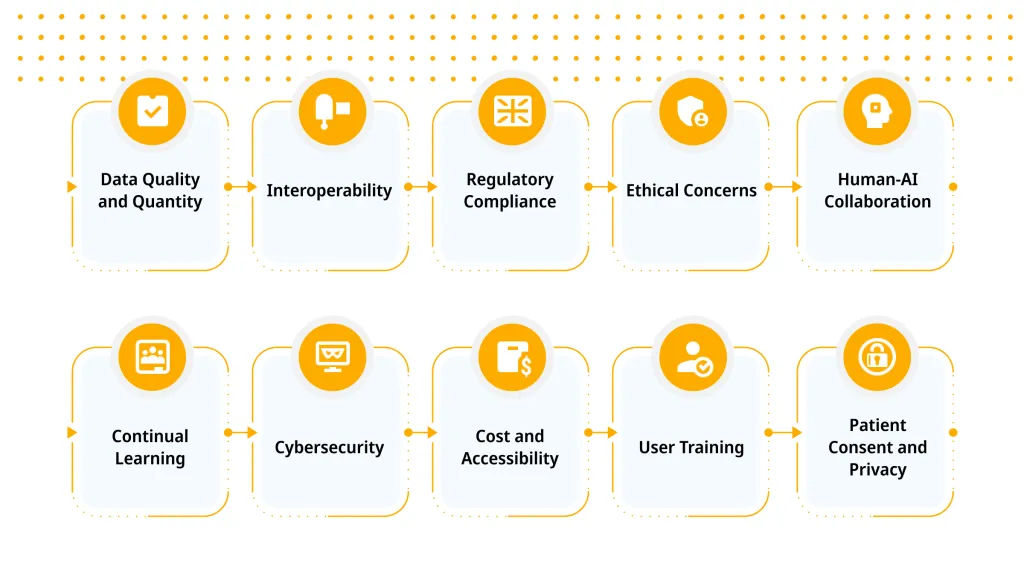
Data Quality and Quantity: ML models rely on large and diverse datasets for training.
Ensuring that these datasets are not only extensive but also accurately represent various medical conditions and patient demographics is crucial.
Using incomplete or biased data can result in inaccurate predictions and diagnoses.
Interoperability: Healthcare institutions often use different software systems and data formats for storing medical images and patient records.
Making ML models compatible with these disparate systems can be technically complex and requires extensive data integration efforts.
Regulatory Compliance: The healthcare sector is subject to strict regulations to protect patient privacy and ensure safety.
Machine Learning applications must comply with regulations like HIPAA and GDPR.
Meeting these standards adds complexity to developing and deploying Machine Learning solutions.
Ethical Concerns: ML algorithms can inadvertently perpetuate biases in the data they are trained on.
This can lead to disparities in diagnoses or recommendations across different patient groups.
Ensuring fairness, transparency, and ethical use of Machine Learning and AI in radiology is an ongoing challenge.
Human-AI Collaboration: Radiologists need to trust and effectively collaborate with AI systems.
Building this trust, ensuring seamless integration into existing workflows, and defining the roles of humans and machines are complex considerations.
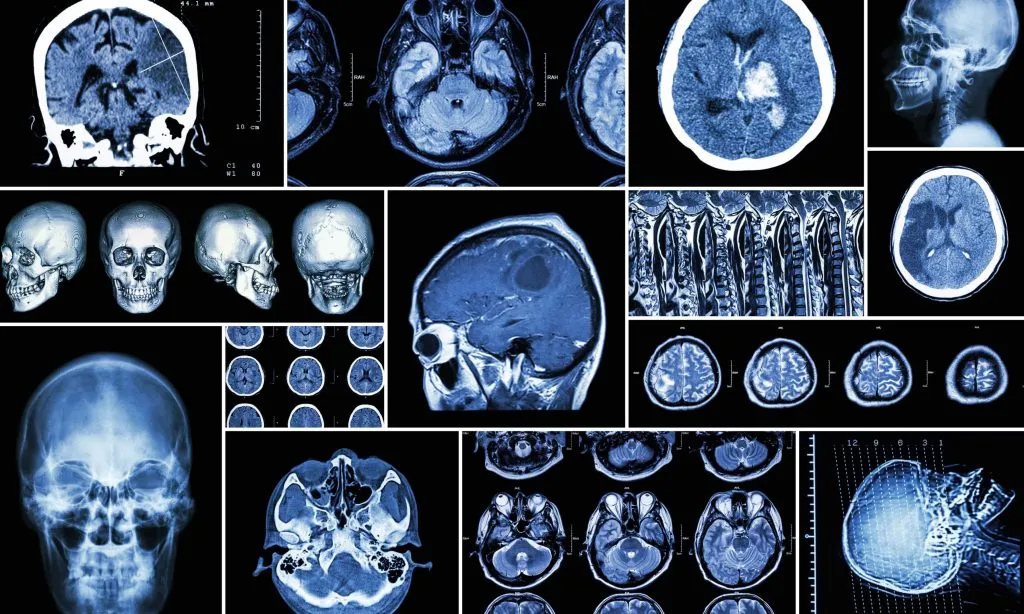
Continual Learning: Medical knowledge and imaging techniques evolve over time.
ML models must adapt to these changes to maintain their accuracy.
Developing mechanisms for continual learning and updating of models is a challenge.
Cybersecurity: As more healthcare data becomes digitized and interconnected, cyberattacks and data breach risk increases.
When you hire Machine Learning engineers in India from ValueCoders, protecting patient data and ensuring the security of ML systems is paramount.
Cost and Accessibility: Implementing ML in radiology is expensive, making it difficult for smaller healthcare facilities or those in resource-constrained settings.
Ensuring that this technology is accessible and affordable for all is a challenge.
User Training: Radiologists and healthcare professionals need training to use ML systems effectively.
Bridging the knowledge gap and providing comprehensive training programs are essential for successful adoption.
Patient Consent and Privacy: Patients should be informed about how their data is used in ML applications and can consent or withhold consent for its use.
Respecting patient privacy and preferences is a critical consideration.
Addressing these challenges requires a multidisciplinary approach by a leading ML development company involving technologists, healthcare professionals, ethicists, and policymakers.
It’s a dynamic process that aims to harness the benefits of ML while safeguarding patient rights, data integrity, and the ethical use of technology in healthcare.
Future Trends and Innovations of ML in Radiology
The future of ML in radiology is incredibly exciting, with several trends and innovations on the horizon that promise to revolutionize healthcare further. Here’s a glimpse into what the future holds:
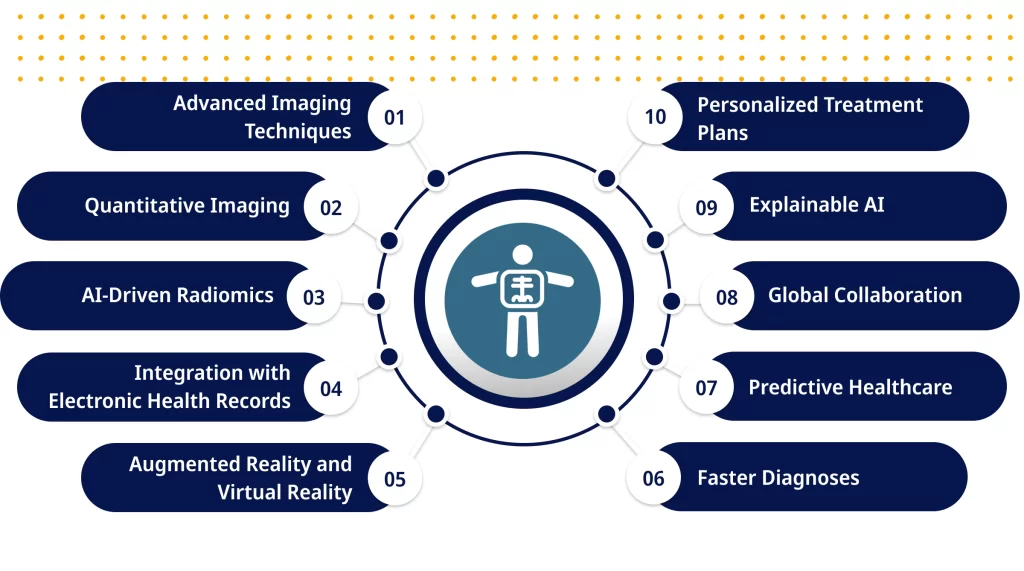
Advanced Imaging Techniques: ML will take existing imaging methods like MRI and CT scans to the next level.
For example, it can enhance the resolution and sensitivity of these scans, enabling doctors to detect subtle abnormalities or track disease progression with greater precision.
Quantitative Imaging: Machine Learning in radiology will enable radiologists to quantify various aspects of medical images, such as measuring the exact size of a tumor, determining tissue properties like density, and calculating blood flow rates.
This quantitative data will provide a more comprehensive understanding of a patient’s condition.
AI-Driven Radiomics: Radiomics involves extracting vast information from medical images using ML algorithms. These algorithms can uncover hidden patterns and relationships within the images, helping predict how diseases behave and how patients respond to treatments.
Integration with Electronic Health Records (EHRs): ML seamlessly connects with electronic health record systems.
When radiologists examine an image, they will have instant access to a patient’s medical history, laboratory results, and other relevant data, enhancing diagnostic accuracy and treatment decisions.
Augmented Reality and Virtual Reality: Expert MLOps consulting services combined with AR and VR technologies will enable radiologists and surgeons to visualize complex anatomical structures in 3D.
This immersive experience will improve surgical planning, medical education, and training.
Faster Diagnoses: ML will continue to reduce the time it takes to analyze medical images.
Quick diagnoses can be life-saving in emergencies, such as identifying a stroke or trauma. ML will assist radiologists by rapidly highlighting critical findings.
Predictive Healthcare: Machine Learning models will become even better at predicting an individual’s disease risk from their genetic makeup, lifestyle, and medical history.
This allows for early interventions and preventive measures to reduce the likelihood of developing certain conditions.
Global Collaboration: Radiologists and data scientists worldwide will collaborate on shared datasets, improving the robustness and accuracy of ML models.
This global cooperation will drive advancements in radiology and patient care.
Explainable AI: As ML models become more complex, there will be a focus on making them transparent and interpretable.
Radiologists need to understand how AI arrives at its conclusions to trust its recommendations and make informed decisions.
Personalized Treatment Plans: ML will analyze vast amounts of patient data to recommend treatment plans tailored to each individual.
By considering genetic factors, treatment response history, and patient preferences, healthcare providers can offer highly personalized care that maximizes effectiveness and minimizes side effects.
These future trends and innovations represent a promising evolution of radiology, where ML plays a central role in improving diagnosis, treatment, and patient outcomes.
By combining the power of technology and medical expertise, radiology is poised to make significant strides in the years ahead.
Conclusion
In the ever-advancing world of healthcare, Machine Learning (ML) is the unsung hero, ushering in a new era of hope and precision.
As we explored the remarkable journey of ML in radiology, it’s crystal clear: the impact is profound, and the potential limitless.
Imagine a future where diseases are caught at their inception, treatments are tailored to individual needs, and machine learning for medical imaging becomes an art of unparalleled accuracy.
ML is the bridge to this future, enhancing image interpretation, optimizing workflows, and offering predictive insights that empower doctors and benefit patients.
But it’s not without challenges- data quality to ethical concerns. Yet, these obstacles are the stepping stones to progress.
With dedication and collaboration, we can overcome them, ensuring that ML in radiology serves everyone equitably.
The horizon looks brighter as we embrace future trends like advanced imaging techniques, augmented reality, and global collaboration.
The stethoscope of the 21st century is the algorithm, and its rhythm is one of promise and possibility.
Machine Learning in radiology isn’t just about enhancing medical imaging; it’s about enhancing lives.
It’s about earlier diagnoses, personalized treatments, and a healthier future.
So, let’s welcome this digital ally into our healthcare journey, for together, we’re painting a portrait of health that’s clearer and brighter than ever before.


